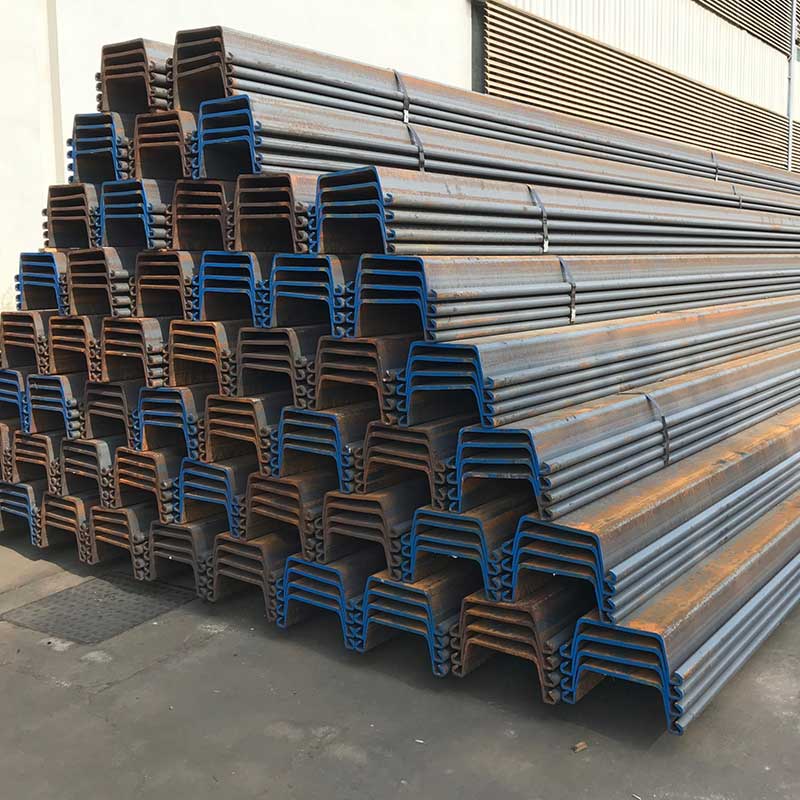أكوام الصلب الصلب تأتي في مجموعة متنوعة من الأشكال, الأحجام, والقياس.
يتم تصنيفها على نطاق واسع في الأنواع التالية:
- أكوام ورقة الصلب Z-type: هذه هي أكثر أنواع الصفائح شيوعًا في أمريكا الشمالية ويمكن استخدامها في مجموعة واسعة من التطبيقات. تم تصنيع z-profiles مع واحدة من ثلاث طرق: ArcelorMittal خطوط, أنتجه خط Mannesmann, يتم لفها; Skyline Steel’s SC, SK, و SM Series متشكلان على البرودة و Tadotsu و Nippon Steel’s NS-SP, JFE/JFESP لديها معامل وسيطة.
- أكوام من صفائح الفولاذ من النوع U: تحتفظ أكوام u الورقة بالتربة والماء تمامًا مثل أكوام Z ذات اختلاف واحد مهم: أكوام u لها التعشيق على المحور المحايد. إن وضع القفل في خط الوسط للجدار يقلل من كفاءة القسم ويمكن أن يسبب مشاكل في التثبيت, لا سيما عندما تكون أعماق القيادة العميقة مطلوبة.
- أكوام ويب مستقيمة: تم تصميم أكوام ورقة الويب المستقيمة لتشكيل cofferdams وتستخدم بالاقتران مع كل من أكوام ورقة Z و U. ليست هذه الأكوام مصممة لمقاومة لحظات الانحناء ولكن يتم استخدامها في التطبيقات التي يلزم وجود جدران الاحتفاظ بها المضمنة.
- نوع المقلاة / أكوام ورقة شبه منحرف: وهي معروفة أيضًا باسم أكوام الصناديق, وتستخدم في هياكل الاحتفاظ الأكبر حجمًا. عادة ما تتشكل عن طريق اللحام أو قفل أكوام الصفائح الفردية معًا لتشكيل مربع أو شكل شبه منحرف.
- أوميغا نوع ورقة أكوام: تشبه هذه الأكوام أكوام Z من النوع ولكن لها شكل مختلف-مثل الحرف اليوناني أوميغا (أوه). غالبًا ما تستخدم أكوام أوراق أوميغا في أوروبا.
- أكوام ورقة Frodingham: These are Z-type sheet piles that were originally made in the UK by the Frodingham Iron Company, hence the name. They are now made by several companies around the world.
- أكوام الصلب الصلب البارد: This type of pile is formed by rolling at ambient temperatures. While they are less expensive than hot-rolled piles, they also have less load-bearing capacity.
- Hot-Rolled Sheet Piles: These are formed by heating steel to high temperatures. Hot-rolled piles have a higher load-bearing capacity but are also more expensive.
Each type of كومة ألواح الصلب is designed for specific applications, and the choice depends on the project requirements, including the design load, ground conditions, وطريقة التثبيت.
What are the advantages of using Z-type Steel Sheet Piles compared to other types?
تجلب أكوام ورقة Z-type عدة مزايا بسبب تصميمها الخاص وتصميم التعشيق. فيما يلي بعض المزايا البارزة:
- قوة عالية: عادةً ما تكون أكوام ورقة Z-type مصنوعة من الصلب عالي القوة, الذي يمنحهم صلابة هيكلية ممتازة. يوفر شكلها معامل مقطع عالي, وهذا يعني أنها يمكن أن تحمل أحمالًا أعلى مقارنة بالأنواع الأخرى.
- تصميم فعال: تقع المتشابك على أكوام ورقة Z في ألياف الجدار الخارجية, بعيدا عن المحور المحايد. ينتج عن هذا الموضع معامل قسم فعال ويوفر مقاومة عالية لحظة الانحناء.
- كفاءة القيادة: عادةً ما يكون لأكوام ورقة Z-type عرضًا كبيرًا, مما يساعد على تقليل عدد التشابك وبالتالي يقلل من احتمال التسرب. يعني العرض الأكبر أيضًا أن هناك حاجة إلى عدد أقل من الأكوام للجدار, توفير وقت التثبيت.
- براعه: Z-type sheet piles can be used for both temporary and permanent applications, and they work well in both straight and curved applications.
- Good Interlock Design: The interlock design on Z-type sheet piles is typically more robust and can accommodate higher tensile loads. This design makes them suitable for high load-bearing walls and high water pressure applications.
- متانة: Like other Steel Sheet Piles, Z-type piles are highly durable and can withstand harsh environmental conditions. They can be coated or treated for additional corrosion resistance.
- قابلية إعادة الاستخدام: Z-type sheet piles can be extracted and reused in other projects, making them a sustainable choice.
It’s important to note that while Z-type sheet piles have many advantages, the choice of sheet pile type should always be based on the specific requirements of the project, including soil conditions, groundwater level, متطلبات التحميل, and cost considerations.







